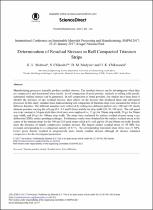JavaScript is disabled for your browser. Some features of this site may not work without it.
- ResearchSpace
- →
- Research Publications/Outputs
- →
- Conference Publications
- →
- View Item
| dc.contributor.author |
Mothosi, KL

|
|
| dc.contributor.author |
Chikosha, Silethelwe

|
|
| dc.contributor.author |
Madyira, DM

|
|
| dc.contributor.author |
Chikwanda, Hilda K

|
|
| dc.date.accessioned | 2017-06-07T07:03:07Z | |
| dc.date.available | 2017-06-07T07:03:07Z | |
| dc.date.issued | 2017-01 | |
| dc.identifier.citation | othosi, K.L., Chikosha, S., Madyira, D.M. et al. 2017. Determination of residual stresses in roll compacted titanium strips. International Conference on Sustainable Materials Processing and Manufacturing, SMPM 2017, 23-25 January 2017, Kruger National Park. In: Procedia Manufacturing, vol. 7: 309-315. https://doi.org/10.1016/j.promfg.2016.12.077 | en_US |
| dc.identifier.issn | 2351-9789 | |
| dc.identifier.uri | http://www.sciencedirect.com/science/article/pii/S2351978916302402 | |
| dc.identifier.uri | https://doi.org/10.1016/j.promfg.2016.12.077 | |
| dc.identifier.uri | http://hdl.handle.net/10204/9134 | |
| dc.description | Article published under a Creative Commons license | en_US |
| dc.description.abstract | Manufacturing processes typically produce residual stresses. The residual stresses can be advantageous when they are compressive and detrimental when tensile. In roll compaction of metal powder, similarly to rolling solid metals, substantial residual stresses can be generated. In roll compaction of metal powders, few studies have been done to identify the presence of any residual stresses, their effects on the process that produced them and subsequent processes. In this study, residual stress induced during roll compaction of titanium strips were measured for strips of different densities. The different densities were achieved by rolling two different particle size (100 and 325 mesh) titanium powders varying the roll gap (0.1, 0.3 and 0.5 mm) and the set strip width (20, 50, 100 mm). The roll speed was kept constant at 10 rpm while three feed rates were employed i.e. 15 g/s for 20 mm strip width, 30 g/s for 50 mm strip width, and 60 g/s for 100 mm strip width. The strips were evaluated for surface residual stresses using x-ray diffraction (XRD) surface probing technique. Preliminary results were obtained for the surface residual stress at the center of the titanium strips for the 100 and 325 mesh strips rolled at 0.1 roll gap for 20 and 50 mm set width. Results show the presence of largely compressive residual stresses. The largest surface residual stress of -55 MPa was recorded corresponding to a compaction density of 83%. The corresponding maximum shear stress was 27 MPa. Lower green density resulted in progressively more tensile residual stresses although all stresses remained compressive for the investigated parameters. | en_US |
| dc.language.iso | en | en_US |
| dc.publisher | Elsevier | en_US |
| dc.relation.ispartofseries | Worklist;18316 | |
| dc.subject | Titanium powders | en_US |
| dc.subject | Density | en_US |
| dc.subject | Residual stress | en_US |
| dc.subject | X-ray diffraction | en_US |
| dc.title | Determination of residual stresses in roll compacted titanium strips | en_US |
| dc.type | Conference Presentation | en_US |
| dc.identifier.apacitation | Mothosi, K., Chikosha, S., Madyira, D., & Chikwanda, H. K. (2017). Determination of residual stresses in roll compacted titanium strips. Elsevier. http://hdl.handle.net/10204/9134 | en_ZA |
| dc.identifier.chicagocitation | Mothosi, KL, Silethelwe Chikosha, DM Madyira, and Hilda K Chikwanda. "Determination of residual stresses in roll compacted titanium strips." (2017): http://hdl.handle.net/10204/9134 | en_ZA |
| dc.identifier.vancouvercitation | Mothosi K, Chikosha S, Madyira D, Chikwanda HK, Determination of residual stresses in roll compacted titanium strips; Elsevier; 2017. http://hdl.handle.net/10204/9134 . | en_ZA |
| dc.identifier.ris | TY - Conference Presentation AU - Mothosi, KL AU - Chikosha, Silethelwe AU - Madyira, DM AU - Chikwanda, Hilda K AB - Manufacturing processes typically produce residual stresses. The residual stresses can be advantageous when they are compressive and detrimental when tensile. In roll compaction of metal powder, similarly to rolling solid metals, substantial residual stresses can be generated. In roll compaction of metal powders, few studies have been done to identify the presence of any residual stresses, their effects on the process that produced them and subsequent processes. In this study, residual stress induced during roll compaction of titanium strips were measured for strips of different densities. The different densities were achieved by rolling two different particle size (100 and 325 mesh) titanium powders varying the roll gap (0.1, 0.3 and 0.5 mm) and the set strip width (20, 50, 100 mm). The roll speed was kept constant at 10 rpm while three feed rates were employed i.e. 15 g/s for 20 mm strip width, 30 g/s for 50 mm strip width, and 60 g/s for 100 mm strip width. The strips were evaluated for surface residual stresses using x-ray diffraction (XRD) surface probing technique. Preliminary results were obtained for the surface residual stress at the center of the titanium strips for the 100 and 325 mesh strips rolled at 0.1 roll gap for 20 and 50 mm set width. Results show the presence of largely compressive residual stresses. The largest surface residual stress of -55 MPa was recorded corresponding to a compaction density of 83%. The corresponding maximum shear stress was 27 MPa. Lower green density resulted in progressively more tensile residual stresses although all stresses remained compressive for the investigated parameters. DA - 2017-01 DB - ResearchSpace DP - CSIR KW - Titanium powders KW - Density KW - Residual stress KW - X-ray diffraction LK - https://researchspace.csir.co.za PY - 2017 SM - 2351-9789 T1 - Determination of residual stresses in roll compacted titanium strips TI - Determination of residual stresses in roll compacted titanium strips UR - http://hdl.handle.net/10204/9134 ER - | en_ZA |






